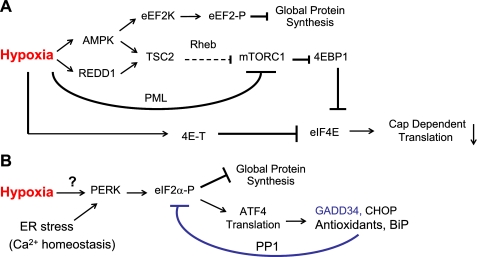FIGURE 1.
Hypoxia inhibits multiple pathways regulating mRNA translation. A and B, schematic diagram of signaling pathways regulating mRNA translation during hypoxia. These include the regulation of translation elongation and availability of eIF4E protein by modulating 4EBP1 phosphorylation (A) and eIF2α phosphorylation (B). A, hypoxia inhibits cap-dependent translation via activating the AMPK/TSC2 and REDD1/TSC2 pathways and promyelocytic leukemia-mediated mTOR nuclear translocation. eIF4E is also regulated by 4E-T sequestration in hypoxic cells. Furthermore, AMPK phosphorylates eEF2 kinase (eEF2K), leading to eEF2 phosphorylation and the inhibition of translation elongation and global protein synthesis. B, hypoxia also inhibits global protein synthesis by PERK-mediated eIF2α phosphorylation. Other stresses (e.g. increased protein load or disruption of protein glycosylation in the ER) and perturbations in Ca2+ homeostasis also result in PERK activation. The ATF4/GADD34/eIF2α negative feedback loop relieves translational inhibition.

